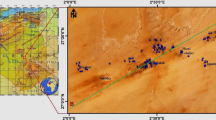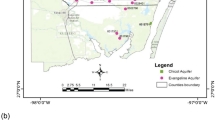Abstract
Hydrochemical, multivariate statistical, and inverse geochemical modeling techniques were used to investigate the hydrochemical evolution within the Ain Azel aquifer, Algeria. Cluster analysis based on major ion contents defined 3 main chemical water types, reflecting different hydrochemical processes. The first group water, group 1, has low salinity (mean EC = 735 μS/cm). The second group waters are classified as Cl–HCO3-alkaline earth type. The third group is made up of water samples, the cation composition of which is dominated by Ca and Mg with anion composition varying from dominantly Cl to dominantly HCO3 plus SO4. The varifactors obtained from R-mode FA indicate that the parameters responsible for groundwater quality variations are mainly related to the presence and dissolution of some carbonate, silicate, and evaporite minerals in the aquifer. Inverse geochemical modeling along groundwater flow paths indicates the dominant processes are the consumption of CO2, the dissolution of dolomite, gypsum, and halite, along with the precipitation of calcite, Ca-montmorillonite, illite, kaolinite, and quartz.









Similar content being viewed by others
References
APHA (American Public Health Association). (1989). Standard methods for examination of water and wastewater (17th ed., p. 1470). Washington, DC: American Public Health Association.
APHA (American Public Health Association). (1995). Standard methods for the examination of water and wastewater (19th ed., p. 1467). Washington, DC: American public Health Association.
APHA (American Public Health Association), AWWA (American Water Works Association), and WPCF (Water Pollution Control Federation). (1995). Standard methods for the examination of water and waste water (19th ed., p. 2000). New York, USA: American Public Health Association.
Attoucheik, L. (2006). Geochemical study of discharges from mining complex of Kherzet Youssef (SETIF) and its environmental impact, thesis, University of Sciences and Technology of Houari Boumediene, Algeria, p. 200.
Bartarya, S. K. (1993). Hydrochemistry and rock weathering in a subtropical lesser Himalayan river basin in Kumaun, India. Journal of Hydrology, 146, 149–174.
Belkhiri, L. (2005). Hydrogeologic study and problem of the groundwater quality in Ain Azel plain, Sétif, East Algerian. Thesis, University of Batna, Algeria, p. 170.
Boutaleb, A. (2001). Mineralizations with Pb-Zn of the Sétifien-Hodna field: Gitology, petrography of dolomites, microthermometry and implications metallogenic. Thesis, University of Sciences and Technology of Houari Boumediene, Algeria, p. 260.
Charlton, S. R., Macklin, C. L., & Parkhurst, D. D. (1997). PHREEQCI: A graphical user interface for the geochemical computer program PHREEQC. US geololgical survey water resources investigation report (97–4222).
Clesceri, L. S., Greenberg, A. E., & Eaton, A. D. (1998). Standard methods for the examination of water and wastewater (20th ed., p. 1220). Washington: American Public Health Association, American Water Works Association, Water Environment Federation.
Dalton, M. G., & Upchurch, S. B. (1978). Interpretation of hydrochemical facies by factor analysis. Groundwater, 16, 228–233.
Danielsson, A., Cato, I., Carman, R., & Rahm, L. (1999). Spatial clustering of metals in the sediments of the skagerrak/kattegat. Applied Geochemistry, 14, 689–706.
Davis, J. C. (1973). Statistics, data analysis in geology (p. 550). N Y: Wiley.
Deutsch, W. J. (1997). Groundwater geochemistry: fundamentals and applications to contamination (p. 221). N Y: Lewis.
Domenico, P. A. (1972). Concepts and models in groundwater hydrology. N Y: McGraw-Hill.
Farnham, I. M., Johannesson, K. H., Singh, A. K., Hodge, V. F., & Stetzenbach, K. J. (2003). Factor analytical approaches for evaluating groundwater trace element chemistry data. Analytica Chimica Acta, 490(1–2), 123–138.
Fovell, R., & Fovell, M. Y. (1993). Climate zones of the conterminous United States defined using cluster analysis. Journal of Climate, 6, 2103–2135.
Freeze, R. A., & Cherry, J. A. (1979). Groundwater (p. 604). Englewood Cliffs: Prentice-Hall.
Galcon, J. (1967). Research on the geology and the metalliferous lodgings of Sétifien Such, thesis natural sciences, geological survey of Algeria, p. 751.
Guiraud, R. (1973). Post-triassic evolution of before country of the Alpine chain of Algeria, according to the study of the El Eulma basin and close areas, thesis natural sciences, Nice, France, p. 270.
Güler, C., & Thyne, G. D. (2004). Hydrologic and geologic factors controlling surface and groundwater chemistry in Indian wells-owens valley area, southeastern California, USA. Journal of Hydrology, 285, 177–198.
Jacks, G. (1973). Chemistry of groundwater in a district in southern India. Journal of Hydrology, 18, 185–200.
Kenoyer, G. J., & Bowser, C. J. (1992). Groundwater chemical evolution in a sandy aquifer in northern Wisconsin: 2. Reaction modeling. Water Resources Research, 28, 591–600.
Kim, J. H., Kim, R. H., Lee, J. H., Cheong, T. J., Yum, B. W., & Chang, H. W. (2005). Multivariate statistical analysis to identify the major factors governing groundwater quality in the coastal area of Kimje, South Korea. Hydrological Processes, 19(6), 1261–1276.
Kumar, M., Ramanathan, A. L., Rao, M. S., & Kumar, B. (2006). Identification and evaluation of hydrogeochemical processes in the groundwater environment of Delhi, India. Journal of Environmental Geology, 50, 1025–1039.
Liu, C. W., Lin, K. H., & Kuo, Y. M. (2003). Application of factor analysis in the assessment of groundwater quality in a blackfoot disease area in Taiwan. The Science of the Total Environment, 313, 77–89.
Love, D., Hallbauer, D., Amos, A., & Hranova, R. (2004). Factor analysis as a tool in groundwater quality management: Two southern African case studies. Physics and Chemistry of the Earth, 29(15–18), 1135–1143.
Mahlknecht, J., Steinich, B., & Navarro de Léon, I. (2003). Groundwater chemistry and mass transfers in the Independence aquifer, central Mexico, by using multivariate statistics and mass-balance models. Environmental Geology, 45(6), 781–795.
Matthess, G. (1982). The properties of groundwater (p. 498). N Y: Wiley.
Olmez, I., Beal, J. W., & Villaume, J. F. (1994). New approach to understanding multiple-source groundwater contamination: Factor analysis and chemical mass balances. Water Research, 28(5), 1095–1101.
Parkhurst, D. L., & Appelo, C. A. J. (1999). User’s guide to PHREEQC (Version 2): A computer program for speciation, batch-reaction, one-dimensional transport, and inverse geochemical calculations. United States geological survey, water resources investigations report 99–4259 (p. 326). Washington DC: Unites States Geological Survey.
Plummer, L. N., & Back, M. (1980). The mass balance approach: Application to interpreting the chemical evolution of hydrological systems. American Journal of Science, 280, 130–142.
Plummer, L. N., Parkhurst, D. L., & Thorstenson, D. C. (1983). Development of reaction models for ground-water systems. Geochimica et Cosmochimica Acta, 47, 665–686.
Reghunath, R., Murthy, T. R. S., & Raghavan, B. R. (2002). The utility of multivariate statistical techniques in hydrogeochemical studies: an example from Karnataka, India. Water Research, 36(10), 2437–2442.
Savornin, J. (1920). Geological investigation of Hodna and Sétifien plate, thesis natural sciences. Lyon, France, p. 200.
Schuh, W. M., Klinekebiel, D. L., Gardner, J. C., & Meyar, R. F. (1997). Tracer and nitrate movements to groundwater in the norruem great plains. Journal of Environment Quality, 26, 1335–1347.
Sharma, S. (1996). Applied multivariate techniques. N Y: Wiley.
STATISTICA® 5.0 for Windows. (1998). StatSoft, Inc.,Tulsa OK. USDA, natural resources conservation services, 1999. Soil taxonomy: A basic system of soil classification for making and interpreting soil surveys. Agriculture handbook no. 436, p. 871.
Suk, H. J., & Lee, K. K. (1999). Characterization of a ground water hydrochemical system through multivariate analysis: clustering into ground water zones. Ground Water, 37(3), 358–366.
Toth, J. (1984). The role of regional gravity flow in the chemical and thermal evolution of groundwater. Proceedings of the first Canadian/American conference on hydrogeology, Banff, Alta.
Vila, J.M. (1980). The alpine chain of eastern Algeria and the Algerian-Tunisian border, thesis of doctorate natural sciences. Paris VI, France, p. 665.
Wallick, E. I., & Toth, J. (1976). Methods of regional groundwater flow analysis with suggestions for the use of environmental isotope and hydrochemical data in groundwater hydrology (pp. 37–64). Vienna: IAEA.
WHO. (2006). Guidelines for drinking-water quality, vol. 1 Recommendations (3rd ed.). Geneva: World Health Organization.
Author information
Authors and Affiliations
Corresponding author
Rights and permissions
About this article
Cite this article
Belkhiri, L., Mouni, L. & Tiri, A. Water–rock interaction and geochemistry of groundwater from the Ain Azel aquifer, Algeria. Environ Geochem Health 34, 1–13 (2012). https://doi.org/10.1007/s10653-011-9376-4
Received:
Accepted:
Published:
Issue Date:
DOI: https://doi.org/10.1007/s10653-011-9376-4




